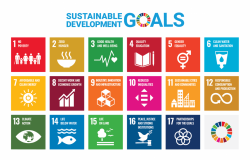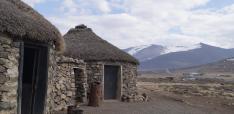GELI Stories – How to get Early Childhood Development into the SDGs (with a bit of help from Shakira)

In the fourth of this series of podcasts with UN and other aid leaders making change happen on the frontline, I talked to UNICEF’s Pia Britto about how she and a group of colleagues managed to include Early Childhood Development in the SDGs.
Firoz Lalji Institute for Africa · GELI Stories - Pia Brito on getting Early Childhood Development into the SDGs
Duncan: Welcome to the GELI Story podcast. I have a very special guest today, Pia Rebello Britto, who is currently the UNICEF representative to the Lao People’s Democratic Republic, previously Global Chief and Senior Adviser for Early Childhood Development at the UNICEF HQ in New York. Before joining UNICEF, she was an academic, Assistant Professor at Yale University, Research Scientist at Teachers College, Columbia University, and she got her doctorate there in developmental psychology. So Pia is a super clever, super experienced person. Welcome Pia!
Pia Britto: Thanks so much, Duncan. I love the superlatives!
Duncan: The reason we got you on, Pia, is because you gave a really interesting talk to the GELI participants on how you and others influenced the Sustainable Development Goal (SDG) process around a topic which you’re really passionate about – early child development. It’s a success story of influencing at a global level and I’d like to talk about how you did it. I don’t think – unless you want to – that we need to rehearse why early child development is absolutely crucial. Lots of people know they are right about a particular issue, whether it’s climate change, early child development, cash transfers … what do you do when you know you’re right, in this case, the science was on your side – what else do you need?
Pia Britto: We had a solution to a problem, which was that the Millennium Development Goals [the forerunners of the SDGs] were strong, but they had a core gap – early childhood development. Brains matter. Good, strong, healthy brain development makes a difference. So you’re right. We had the solution. I think that the idea was that to get from here to there, we were almost building the road as we went along because the path for the development of the Sustainable Development Goals, the processes themselves were also being built.
In 2013, the idea was that the Sustainable Development Goals should involve the whole world. It shouldn’t just be a few people. So every time the Sustainable Development Goals came up with a new process, we had to be able to understand, how are we going to infiltrate it? And infiltrate it in a way that a small band or a small group of people or the platform of UNICEF can make a difference. And I think that was one tactical strategy that was continually being used.
When we were assessing the different work streams that were going into forming the Sustainable Development Goals, whether it was the high-level panel of people or the different working groups that were being formed, we were very cognisant of the fact that UNICEF has a tremendous reputation and a tremendous credibility in being able to advocate for children’s rights. So starting with that platform and the leadership of UNICEF, we would do an assessment to say, how can we have a winning strategy? If it was with the different working groups, do we take more of an academic lens? If it’s with the conference of the mayors, do we get one of the mayors to be the spokesperson? If it’s at the General Assembly, do we get a head of state? So in each case, I would say it was leveraging the platform of UNICEF to then bring the influencer who has a voice in that process to deliver the message. I’m not sure this was an approach we were doing unknowingly or knowingly, but it was very much the way we were trying to find the influencer – it’s all about the ‘who’.
Duncan: So this band of heroes: how many of you were there? Did you have a WhatsApp group? Or maybe this is pre-WhatsApp. Did you have a conscious identity of ‘we are going to get early child development into the SDGs?’
Pia Britto: I think this was a goal we set, but I wouldn’t say there was a very tightly defined group. There was a community of academics, development partners, civil society partners and key actors who believed in this solution. We were all informed, keeping each other going in terms of what can make a difference. The academics were very conscious that we needed to get a core academic paper series out in the Lancet; the philanthropic group was very clear that they needed to influence all the philanthropic circle who were a big part of the Sustainable Development calls. The data group was very clear that they had to work with those who were finalising the indicators for the SDGs. So each group knew their role and would keep each other informed. There wasn’t a core communication that went out, but it was a lot of moving with the times and remaining dynamic. But everyone knowing that that’s our goal, I think everyone had one goal in mind.
Duncan: So a clear goal, it sounds like you had a lot of long-term relationships in there, which means trust. You don’t have to spend ages explaining things to each other. You’ve got that ability to just work together on the fly. Is that right?
Pia Britto: Yes. And now that we’re thinking back, I think we had a few very good communicators in our group also. That’s key to influencing because science in and of itself can be quite dry. We had the likes of Jack Shonkoff at the Harvard Center for the Developing Child, who tells the most eloquent story to any audience.
Duncan: You’re not a bad communicator yourself, I remember when you gave the talk, you were talking about baking inequality into the brains of babies, which is both amazingly alliterative and really sticks with you. Clearly, you had some very good narratives which were very powerful to people just as human beings, right?
Pia Britto: That’s a phrase that the President of the World Bank, Jim Kim, made very well known because the World Bank took this on. Tony Lake from UNICEF was die-hard on this message. Everywhere he went – to every head of state, every UN meeting, he delivered this message. These influencers really played a role.
Duncan: How did you do that? On the GELI course, we get people to do map how much stakeholders agree with your issue v how influential they are. So you identify powerful allies and less powerful allies, or you can maybe put the less powerful in touch with the powerful allies as a whole process to build a coalition. Did you do that kind of thing or was it much more just instinctive?
Pia Britto: We mapped all the key moments where decisions were going to be made for the SDGs. So I think we were mapping more the process than the people. We knew there were certain points at which the narrative was going to go to its next iteration, go into finalisation. So how do we influence those and who are the people who can make that happen?
Duncan: And I believe you got Michelle Bachelet involved quite a lot. She was one of your ambassadors, is that right?
Pia Britto: Exactly. She’s another champion of this agenda. It was actually her political campaign in Chile on which she ran for president. And she created a national program which is really a lighthouse for this work. It’s called Chile Crece Contigo: Chile Grow With You. Again, we knew the General Assembly was a very important influencing point. So we worked back from there and said who could actually speak to it? And it was her. Then we went to meet her and asked her to chair an event just the day before the General Assembly. It took a lot of planning, but it was all about spotting milestone moments and then leveraging the platform of UNICEF and this band of people who had been working for a while on the agenda. And just to say, we didn’t have much of a budget at all. It was really shoestring!
Duncan: The Chile story also brings in a brilliant proof of concept at a large scale. People want to see that it’s worked somewhere if they’re going to take it on. I can imagine that was a big plus. Now, how do you deal with the problem of exhaustion and stamina? I mean, the SDGs were interminable. I remember my first SDG meeting, I think, was in 2010 or something. How did you keep going? How did you do it on a personal level and on an organisational level?
Pia Britto: I think that we really were determined. I know I was determined that this had to happen come hell or high water. I don’t know how else to explain it, but sheer grit. We just kept going. I think also what helped us a bit is that we started to see some traction, some buzz. Suddenly, the education community started to invite the early childhood world there and say. So what is it that you’re trying to say? That’s quite motivating. And then when the mayors got together and the mayor of Istanbul hosted the mayors conference and they said, let’s put this on the agenda. Those moments really give you a lift that you are being heard. All of these little successes along the way definitely were motivators that we’re on the right road.
Duncan: So you get to the big SDGs event. Tell us the Shakira story!
Pia Britto: Yeah, that was probably one of the most exciting days, and a pivotal moment. We’d got into the SDGs, which was great, but so did 150 other issues. How do you make your issue stand out and catch the eye? The media want something interesting, they want something new. And the media are going to cover what the Secretary General says that day. So then again, we work back and say, how do we get the attention of the Secretary General? Everyone’s clamouring for his attention. And we thought, why don’t we bring in a non-traditional Goodwill Ambassador like Shakira? She’s not really known in the SDG world, but she’s passionate about young children, about education. Everyone likes her music. I think the Secretary General may have also liked her music!
We also took the first slot that morning. The door opens at 6:30 or 7. We said we wanted the first slot – ours had to be the first event. We snuck Shakira in. We got the whole event started. So the first headline that came out that day was the first quote by the Secretary General that the cornerstone of the SDGs is early childhood development. You could have been running an event in the middle of the day, equally important but by then the media cycles are getting tired. And so that was our very strategic planning to capture the media. And then we won the headlines after that, which was pretty impressive.
Duncan: It’s a phenomenal story. You hit just about every button of the things we’re talking about, the course: understanding the process, understanding the stakeholders, timing, stamina, the incentives of everybody involved. I mean, it is just superb. Just one final question – was it worth it? Has it made a difference on the ground?
Pia Britto: Yes and no. I was recently in an ASEAN meeting. I was blown away that the ASEAN ministerial dialogue was talking about early childhood in a very significant way. I think the entire SDG agenda has taken a hit with the pandemic, and that has really reshaped a big part of what we’re able to achieve. And we know we’re halfway through, but we’re nowhere near halfway achieving the goals. So I think that the entire agenda has taken a hit, but we’re in it. And this is something that governments are being held accountable for. So it is definitely making a difference. But all the SDGs are fragile and under threat right now.
Duncan: Okay, but it’s making a difference. Let’s finish on the positive. A superb example of influencing, which I’m sure will inspire GELI participants and others. Thanks very much, Pia.
The Global Executive Leadership Initiative - GELI - is a leadership development programme designed exclusively for top-level leaders from the United Nations, NGOs, and the Red Cross and Red Crescent Movement. Global Policy's Tom Kirk facilitates it alongside Duncan.


